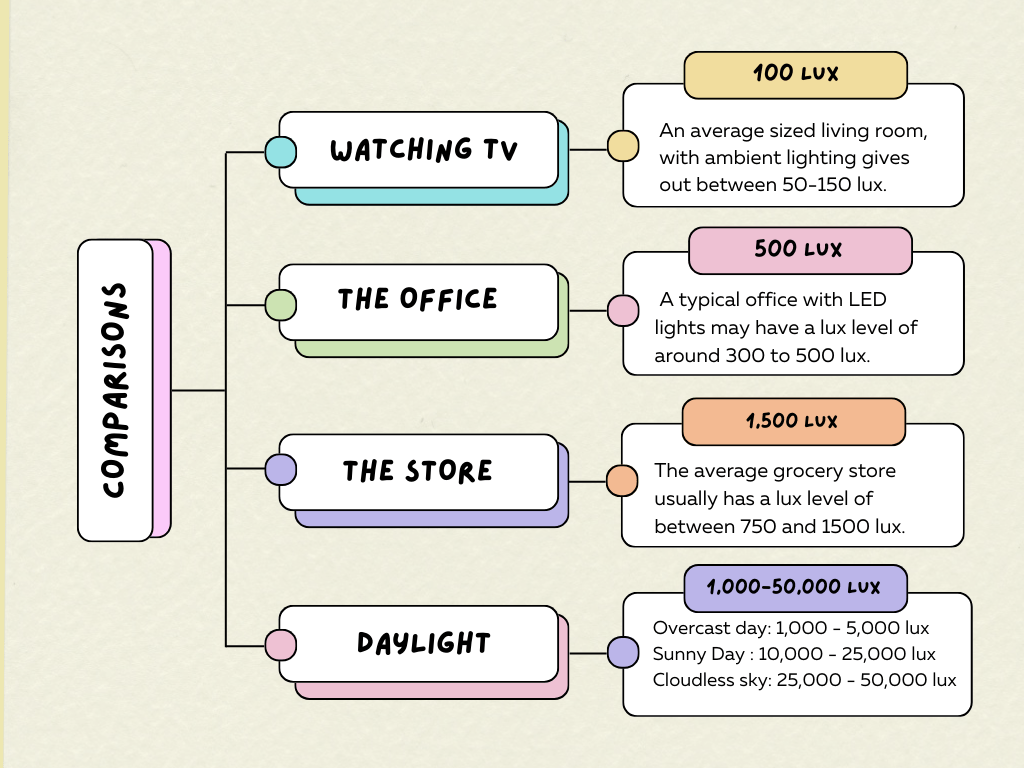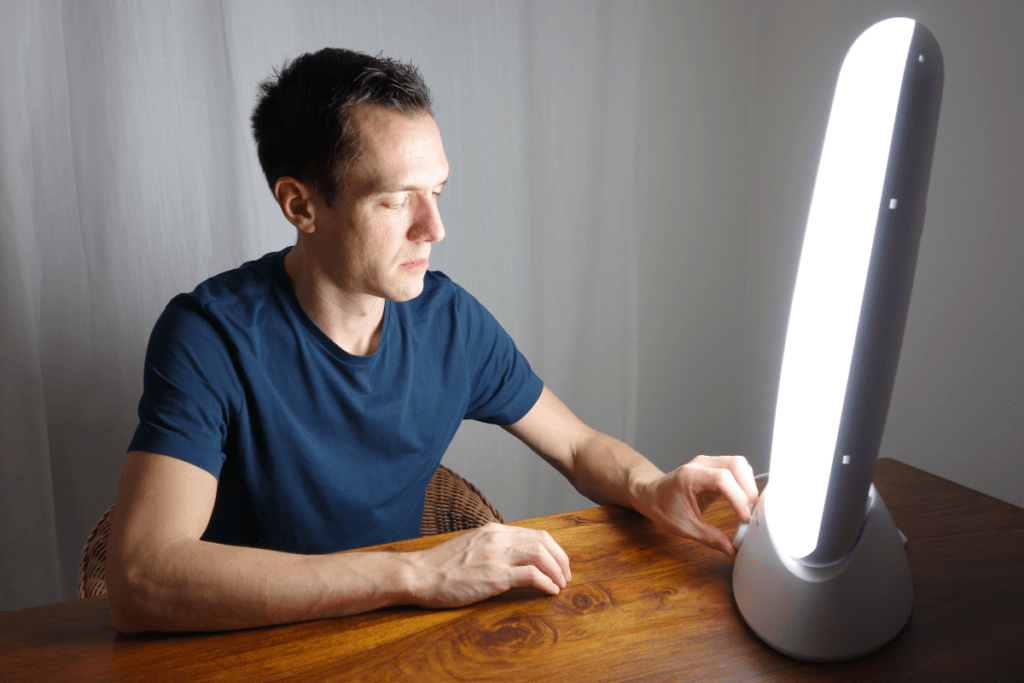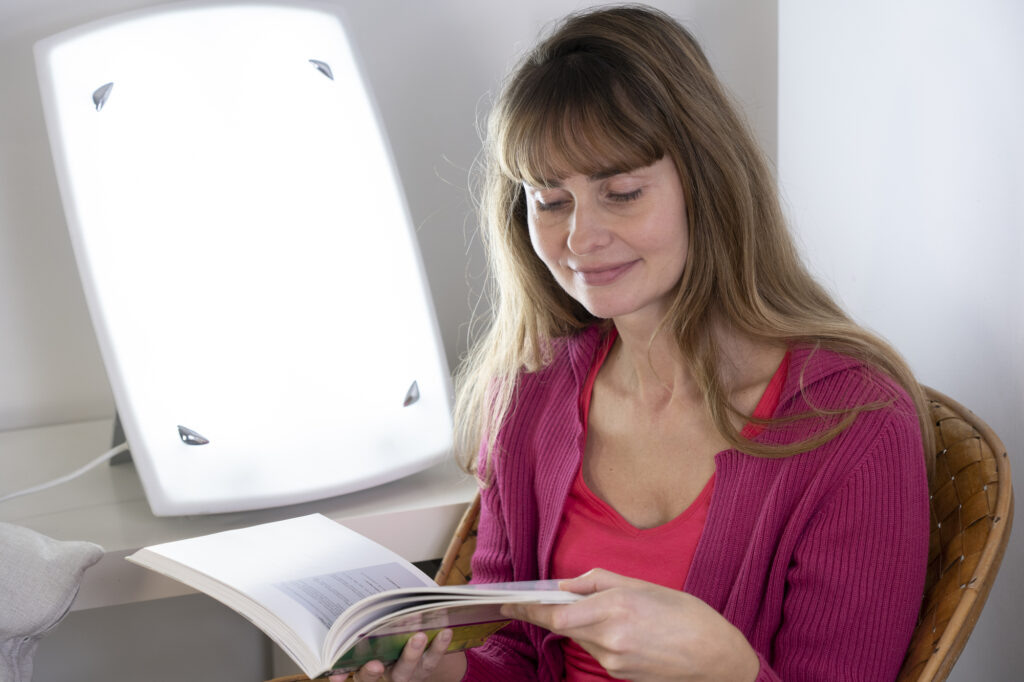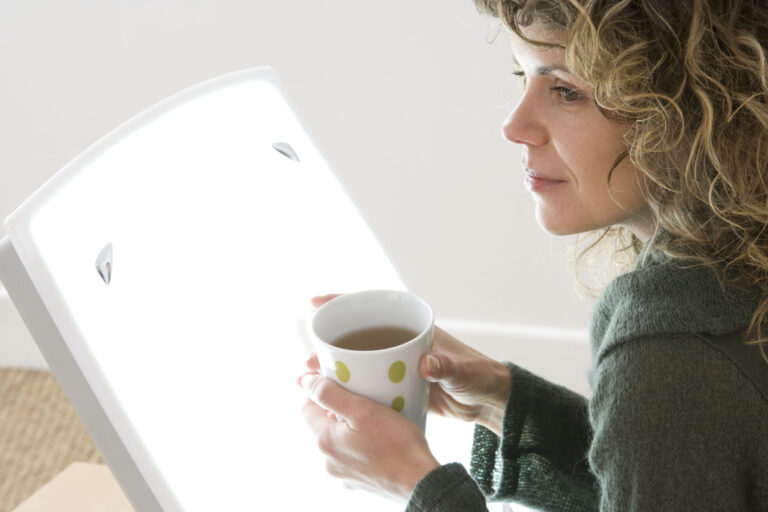Using Your Lightbox 101 for Winter Blues: A Guide to Beating Seasonal Affective Disorder
Light therapy has been proven to be an effective treatment for the winter blues, also known as seasonal affective disorder (SAD). SAD is a type of depression that affects people during the fall and winter months when there is less natural sunlight. Symptoms include feeling depressed, having low energy, being unable to wake up or difficulty in sleeping, and a loss of interest in normal activities or socializing,
Using a lightbox is a first line of defence that can help alleviate the symptoms of SAD. A lightbox is a device that emits bright artificial light, mimicking the effects of natural sunlight. It is important to choose the right lightbox, set it up correctly, and use it consistently to see the full benefits.
Read the Instructions!
Most reputable manufacturers will include instructions for using your lightbox to minimize any side-effects. Read them! However if you have mislaid them then this article will cover the basics to using your lightbox, including some common mistakes to avoid.
A note on Lux
Illuminance is an way to gauge the brightness of a surface. It tells you how much light is falling on a square meter of that surface. The units we use to measure illuminance are called lux, and they indicate the amount of light hitting that square meter. The more light that showers a surface, the brighter it becomes.
I’m going to use a cake analogy to explain this. Imagine a small cake with loads of icing or frosting. It’s probably thick and flavorsome.

Now, imagine taking that same amount of icing and spreading it over a large cake. The sweetness and richness are going to become a bit less intense, because it is so much thinner. Well, the same applies to light. If you have a ton of light concentrated on a small area, it will be dazzlingly bright. However, if you spread that same amount of light over a bigger area, it won’t shine with the same level of brightness.
Let’s break it down further. Suppose you have 1000 units of light. If you focus all that light on just one square meter, boom, you’ll have 1000 lux of brightness! But, if you decide to spread that same 1000 units of light over a larger area, say 10 square meters, the brightness drops to 100 lux.
A lightbox should be at least 10.000 lux which is the level of brightness of a sunny day. Some lamps might output less lux and will require you to spend longer in front of them.
To put this into context most indoor lights are between 500 and 1000 lux. An overcast day might be a minimum of 1000 lux. A very overcast dark day such as we might get between November and January can be as little as 100 lux! Sitting bathed in full sunlight in the middle of summer you might get as much as 100,000 lux.

Choosing a Lightbox
When choosing a lightbox, there are a few important factors to consider. First, make sure the lightbox emits full-spectrum light, which mimics natural sunlight. This is important because it helps regulate our circadian rhythm and can improve mood and energy levels.
Another important factor is the type of bulbs used in the lightbox. Look for UV-filtered bulbs, which protect your skin and eyes from harmful UV rays. This is especially important if you plan on using the lightbox for longer periods of time.
In terms of recommended specifications, the lightbox should emit at least 10,000 lux of light and be positioned at a distance of about 16-24 inches from your face. It’s also important to use the lightbox for at least 30 minutes a day, preferably in the morning, to see the most benefits. Some instructions may say between 30-60 minutes a day, and you can often break this down into smaller sessions throughout the day.
When shopping for a lightbox, consider the size and portability as well. A smaller, more portable lightbox may be more convenient for travel or for use in different rooms of your home.
Overall, choosing the right lightbox can make a big difference in alleviating winter blues. Make sure to do your research and select a high-quality lightbox that meets your specific needs.
Set up the Lightbox
To use your lightbox effectively, the first step is to set it up in a convenient location. I recommend placing it on a table or desk in a room where you spend a lot of time, such as your bedroom or home office. Make sure there is a nearby power outlet so you can easily plug it in.
Check your distance. My BOXelite gives 10,000 lux at a distance of 14 inches, but a Luxor Desk Lamp delivers 10,000 lux at 12 inches. This was my first lamp and I needed to sit 18 inches away from it for the best benefit.
Position the Lightbox
To get the most benefit, it is important to position it correctly. I recommend placing the lightbox at eye level, about 16-24 inches away from your face. This will ensure that the light is hitting your eyes at the correct angle and intensity.. The light should be facing you, and you should be sitting or standing about 12-18 inches away from it. You can adjust the angle of the light to make sure it’s shining directly on your face. You do not need to look directly into the light but it should be in your field of vision. Do not wear sunglasses – this will defeat the object of the exercise.

If you are using your lightbox at work or while doing other activities, you may need to adjust the height and angle of the lightbox to ensure that it is hitting your eyes at the correct angle. Some lightboxes come with adjustable stands or brackets that can be used to position the lightbox at the correct height and angle.
It is also important to consider the brightness of the lightbox. Most lightboxes have adjustable brightness settings, which can be used to customize the light intensity to your individual needs. Start with a lower brightness setting and gradually increase it over time, as your eyes become accustomed to the light.
Use the Lightbox
Once you’ve found the perfect spot for your lightbox, it’s time to start using it. Start with just 10-15 minutes of light therapy per day, and gradually increase the time to 30 minutes a day if you feel comfortable or more as per your manufacturers instructions.
Consistency in Light Therapy
Consistency is key when it comes to light therapy for the winter blues. It’s important to establish a consistent regimen and stick to it for optimal results.
It can be helpful to use a lightbox with a timer or set a timer on your phone or other device. This will help you keep track of the duration of your sessions and ensure that you’re getting the recommended amount of light exposure.
To get the most out of your lightbox, it’s important to use it at the same time every day. This will help regulate your body’s natural sleep-wake cycle and improve your mood. I advise using the lightbox in the morning, as this will help you feel more alert and energized throughout the day. The most optimum time seems to be before 08:00 am but most people will use it as soon as they get up.
It’s best to use the lightbox in the morning, as exposure to bright light early in the day can help reset our internal clock and improve our sleep quality. However, individual needs and preferences may vary, so feel free to experiment with different times of day to find what works best for you. I do suggest that you don’t use it in the evenings though unless you like to have disturbed nights!
In addition to consistency in duration and timing, it’s also important to maintain consistency in the type of lightbox used. Different lightboxes may emit different wavelengths or intensities of light, which can affect the efficacy of the therapy. We recommend using a lightbox that is specifically designed for light therapy and has been clinically tested for effectiveness.
Overall, establishing a consistent regimen for light therapy is essential for treating the winter blues. By paying attention to your symptoms, adjusting your regimen as needed, and using a high-quality lightbox, you can effectively manage your symptoms and improve your mood and energy levels.
Common Mistakes
When using a lightbox for the first time, it’s easy to make mistakes that can reduce the effectiveness of treatment. In this section, I’m going to show the most common mistakes made by users and provide tips on how to avoid them.

Mistake 1: Not Sitting Close Enough
The strength of the light is what makes light therapy effective. Recommended light therapy lamps are 10,000 LUX, which is the needed light intensity for an effective treatment. The ideal sitting distance is 16″ to 24″ but will vary based on the size and strength of the lamp. Most people make the mistake of sitting too far away from their light therapy box. Sitting further away reduces the strength of the light that gets to your eyes.
To avoid this mistake, make sure to sit at the recommended distance from your therapy lamp. If sitting close to the lamp is uncomfortable for you, try sitting at a comfortable distance for more extended periods. This additional time will make up for the reduced LUX reaching your eyes.
Mistake 2: Not Letting the Light Hit Your Eyes
For treatment to be most effective, you need to be sitting in front of your lamp with the light positioned over your eye-level at an angle. This angle lets the light shine directly in your eyes’ cornea. If your lamp does not shine into your eyes’ cornea, it can mimic the effect of sunlight for those essential hormones.
To avoid this mistake, make sure to position your therapy lamp at the correct angle. Many lamp product images show incorrect usage, so it’s important to read the instructions carefully. Remember, the light needs to shine directly into your eyes for maximum effectiveness.
Mistake 3: Improper Timing
Consistency is key when it comes to light therapy. To feel the benefits, you need to continuously use it. We recommend 20 to 30 minutes each day within one hour of waking up. It’s always a great practice to incorporate your therapy lamp treatment sessions into your daily routine (such as while you’re getting ready for work, eating breakfast, at your desk, etc.).
To avoid this mistake, make sure to use your therapy lamp every day at the same time. Set a reminder if you need to. It’s also important to start treatments early in the fall when days become shorter. Doing so allows your body to maintain its serotonin and melatonin levels.
Mistake 4: Not Changing/Replacing the Bulb
While light therapy lamps use high-intensity bulbs to emit 10,000 LUX, they share similar characteristics with regular light bulbs. One being is their light intensity becomes weaker with use. As you continue to use your therapy lamp, the bulb will become weaker, which means you won’t get the same level of treatment.
To avoid this mistake, make sure to change your light therapy bulb after two years regardless if it’s burnt out or not. This ensures that you receive the needed 10,000 LUX for an effective treatment. Keep an eye on your lamp’s brightness. If you notice it’s starting to dim, it may be time to replace the bulb or lamp.
Mistake 5: Not Using Other Treatment Methods
Light therapy is not a stand-alone treatment. It’s important to incorporate other treatment methods into your regimen, such as yoga, meditation, exercise, and outdoor activities. Failure to implement other lifestyle changes often leads to ineffective light therapy treatments.
To avoid this mistake, try implementing other treatment methods into your daily routine. Yoga, meditation, exercise, and outdoor activities are all great options. Remember, light therapy works best when accompanied by other health and wellness practices.
Mistake 6: Not Keeping Track of Side Effects
While light therapy is relatively safe, it’s not without potential side effects. It’s important to keep track of any side effects that may occur. This is especially important if you have any existing conditions.
To avoid this mistake, make sure to keep track of any side effects that you may experience. If you notice any adverse effects, stop using your therapy lamp and consult with your healthcare provider.
Mistake 7: Using a Lamp that’s Too Strong
Using a lamp that’s too strong can cause eye strain and other adverse effects. It’s important to choose a therapy lamp that’s appropriate for your needs.
To avoid this mistake, make sure to choose a therapy lamp that’s appropriate for your needs. If you’re not sure which lamp to choose, consult with your healthcare provider or a mental health professional.
By avoiding these common mistakes, you can get the most out of your light therapy treatment.

Conclusion
Overall, setting up and using a lightbox is a simple and effective way to combat the winter blues. With just 30-60 minutes a day, you can improve your mood, increase your energy levels, and feel more productive and focused throughout the day.
It’s also important to pay attention to your symptoms and adjust your regimen accordingly. If you’re not seeing improvement after a few weeks of consistent use, you may need to increase the duration or intensity of your sessions. On the other hand, if you’re experiencing side effects such as headaches or eye strain, you may need to decrease the duration or intensity.
Remember, light therapy can be highly effective when used properly.

Frequently Asked Questions
What is light therapy and how can it help alleviate symptoms of seasonal affective disorder?
Light therapy is a non-invasive treatment that involves exposure to bright artificial light to help alleviate symptoms of seasonal affective disorder (SAD). SAD is a type of depression that typically occurs during the winter months when there is less natural sunlight. Light therapy works by mimicking natural sunlight and regulating the body’s circadian rhythm, which can help improve mood, energy, and sleep patterns.
Are there any potential side effects of using a SAD desk lamp?
While light therapy is generally considered safe, there are some potential side effects to be aware of. These can include headaches, eyestrain, and nausea. It is important to follow the manufacturer’s instructions and to start with a low-intensity light box and gradually increase the exposure time. If you experience any discomfort or adverse effects, you should discontinue use and consult your healthcare provider.
What is the recommended duration and frequency of light therapy sessions for seasonal depression?
The recommended duration and frequency of light therapy sessions can vary depending on the severity of your symptoms and the type of light box you are using. Generally, it is recommended to start with a 10-15 minute session per day and gradually increase the duration to 30-60 minutes. Light therapy is typically most effective when used in the morning, but it can also be used in the evening if necessary. It is important to consult with your healthcare provider to determine the best treatment plan for your individual needs.
How do I properly use a light box for treating winter blues?
To properly use a light box for treating winter blues, you should first ensure that the light box is positioned at the correct distance and angle. Typically, this is around 16-24 inches away and at a 30-degree angle. You should then sit in front of the light box with your eyes open but not staring directly at the light. You can engage in activities such as reading or working while using the light box, but it is important to avoid looking directly at the light for prolonged periods of time.
What is the difference between red light therapy and blue light therapy for seasonal affective disorder?
Red light therapy and blue light therapy are two types of light therapy that are sometimes used to treat seasonal affective disorder. Red light therapy involves exposure to red light wavelengths, which are believed to promote healing and reduce inflammation. Blue light therapy, on the other hand, involves exposure to blue light wavelengths, which are believed to regulate the body’s circadian rhythm and improve mood. While both types of therapy may be effective for treating seasonal affective disorder, it is important to consult with your healthcare provider to determine which type of therapy is best for your individual needs.
Related Posts:






